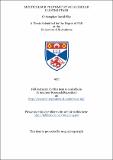Files in this item
Multicolour photometry of globular cluster stars
Item metadata
| dc.contributor.advisor | Hill, Philip W. | |
| dc.contributor.author | Pike, Christopher David | |
| dc.coverage.spatial | 176 p. | en_US |
| dc.date.accessioned | 2018-06-21T14:06:51Z | |
| dc.date.available | 2018-06-21T14:06:51Z | |
| dc.date.issued | 1977 | |
| dc.identifier.uri | https://hdl.handle.net/10023/14408 | |
| dc.description.abstract | The underlying theme of this thesis is the application of electronography to the study of stars in globular clusters through the use of both broad and intermediate-band photometric systems. Introductions to both the study of globular clusters and to the use of electronography are given in Chapter 1. In Chapters 2 and 3 observations based upon electronographic exposures are presented for two little-studied clusters, NGC 5053 and NGC 6366. Both are loose, sparsely populated clusters but despite their similarity in appearance, the photometry shows that NGC 5053 is an unreddened, metal-poor globular, while NGC 6366 is found to be a highly reddened metal-rich cluster. One variable star in NGC 6366 is shown to be an a-type RR Lyrae - an unusual occurrence in a cluster of high metallicity. Chapter 4 describes developments in the reduction of stellar electronographs made by the author. An automatic method of fitting Gaussian profiles to the density volumes is shown to produce photometry as accurate and linear as previous manual techniques, but with a much increased efficiency. This work is extended to investigate the use of more flexible profiles which are then shown to be useful for allowing photometry of crowded images. Finally, an application of the Gaussian profile fitting routines to photographic stellar photometry is discussed. Chapter 5 reports the use of this reduction scheme on photographic plates of the globular cluster M 15. Using the David Dunlap Observatory (DDO) intermediate-band photometric system, cluster members are easily distinguished from foreground dwarfs. Chapter 6 describes the results of a programme of DDO electronography of the globular clusters M 5 and M 13. An accuracy of 0.03 is obtained for the DDO colours which, although comparable with some earlier photoelectric work, shows that, with the observational and reduction techniques employed, electronographic stellar photometry has not yet attained its potential as two-dimensional photoelectric photometry. | en_US |
| dc.language.iso | en | en_US |
| dc.publisher | University of St Andrews | |
| dc.subject.lcc | QB853.P5 | |
| dc.subject.lcsh | Stars--Clusters | en |
| dc.title | Multicolour photometry of globular cluster stars | en_US |
| dc.type | Thesis | en_US |
| dc.contributor.sponsor | Science Research Council (Great Britain) | en_US |
| dc.type.qualificationlevel | Doctoral | en_US |
| dc.type.qualificationname | PhD Doctor of Philosophy | en_US |
| dc.publisher.institution | The University of St Andrews | en_US |
This item appears in the following Collection(s)
Items in the St Andrews Research Repository are protected by copyright, with all rights reserved, unless otherwise indicated.

